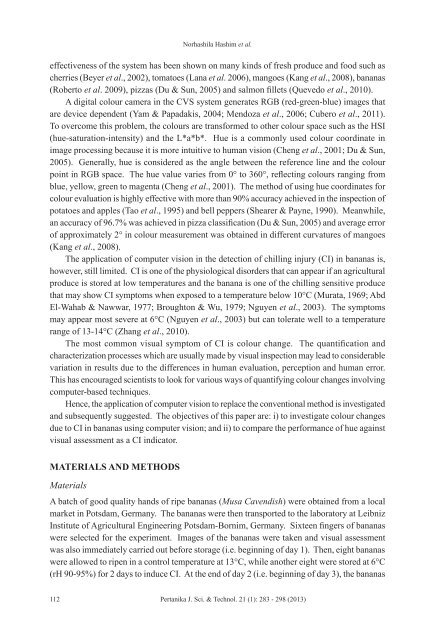JST Vol. 21 (1) Jan. 2013 - Pertanika Journal - Universiti Putra ...
JST Vol. 21 (1) Jan. 2013 - Pertanika Journal - Universiti Putra ...
JST Vol. 21 (1) Jan. 2013 - Pertanika Journal - Universiti Putra ...
Create successful ePaper yourself
Turn your PDF publications into a flip-book with our unique Google optimized e-Paper software.
Norhashila Hashim et al.<br />
effectiveness of the system has been shown on many kinds of fresh produce and food such as<br />
cherries (Beyer et al., 2002), tomatoes (Lana et al. 2006), mangoes (Kang et al., 2008), bananas<br />
(Roberto et al. 2009), pizzas (Du & Sun, 2005) and salmon fillets (Quevedo et al., 2010).<br />
A digital colour camera in the CVS system generates RGB (red-green-blue) images that<br />
are device dependent (Yam & Papadakis, 2004; Mendoza et al., 2006; Cubero et al., 2011).<br />
To overcome this problem, the colours are transformed to other colour space such as the HSI<br />
(hue-saturation-intensity) and the L*a*b*. Hue is a commonly used colour coordinate in<br />
image processing because it is more intuitive to human vision (Cheng et al., 2001; Du & Sun,<br />
2005). Generally, hue is considered as the angle between the reference line and the colour<br />
point in RGB space. The hue value varies from 0° to 360°, reflecting colours ranging from<br />
blue, yellow, green to magenta (Cheng et al., 2001). The method of using hue coordinates for<br />
colour evaluation is highly effective with more than 90% accuracy achieved in the inspection of<br />
potatoes and apples (Tao et al., 1995) and bell peppers (Shearer & Payne, 1990). Meanwhile,<br />
an accuracy of 96.7% was achieved in pizza classification (Du & Sun, 2005) and average error<br />
of approximately 2° in colour measurement was obtained in different curvatures of mangoes<br />
(Kang et al., 2008).<br />
The application of computer vision in the detection of chilling injury (CI) in bananas is,<br />
however, still limited. CI is one of the physiological disorders that can appear if an agricultural<br />
produce is stored at low temperatures and the banana is one of the chilling sensitive produce<br />
that may show CI symptoms when exposed to a temperature below 10°C (Murata, 1969; Abd<br />
El-Wahab & Nawwar, 1977; Broughton & Wu, 1979; Nguyen et al., 2003). The symptoms<br />
may appear most severe at 6°C (Nguyen et al., 2003) but can tolerate well to a temperature<br />
range of 13-14°C (Zhang et al., 2010).<br />
The most common visual symptom of CI is colour change. The quantification and<br />
characterization processes which are usually made by visual inspection may lead to considerable<br />
variation in results due to the differences in human evaluation, perception and human error.<br />
This has encouraged scientists to look for various ways of quantifying colour changes involving<br />
computer-based techniques.<br />
Hence, the application of computer vision to replace the conventional method is investigated<br />
and subsequently suggested. The objectives of this paper are: i) to investigate colour changes<br />
due to CI in bananas using computer vision; and ii) to compare the performance of hue against<br />
visual assessment as a CI indicator.<br />
MATERIALS AND METHODS<br />
Materials<br />
A batch of good quality hands of ripe bananas (Musa Cavendish) were obtained from a local<br />
market in Potsdam, Germany. The bananas were then transported to the laboratory at Leibniz<br />
Institute of Agricultural Engineering Potsdam-Bornim, Germany. Sixteen fingers of bananas<br />
were selected for the experiment. Images of the bananas were taken and visual assessment<br />
was also immediately carried out before storage (i.e. beginning of day 1). Then, eight bananas<br />
were allowed to ripen in a control temperature at 13°C, while another eight were stored at 6°C<br />
(rH 90-95%) for 2 days to induce CI. At the end of day 2 (i.e. beginning of day 3), the bananas<br />
112 <strong>Pertanika</strong> J. Sci. & Technol. <strong>21</strong> (1): 283 - 298 (<strong>2013</strong>)





